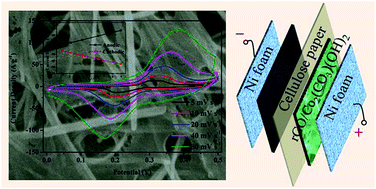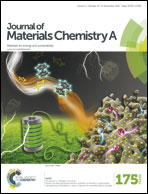A novel open architecture built by ultra-fine single-crystal Co2(CO3)(OH)2 nanowires and reduced graphene oxide for asymmetric supercapacitors†
Abstract
Recently, hydroxyl-carbonates have drawn increasing interest in energy storage because of their special layered structure and pseudocapacitive character. In this work, a novel open architecture based on reduced graphene oxide and ultra-fine single-crystal Co2(CO3)(OH)2 nanowires (designed as rGO/Co2(CO3)(OH)2) is synthesized via mutual electrostatic interactions benefiting from their intrinsic opposite charges. Taking advantage of the high conductivity of rGO, the ultra-fine diameter of the nanowires, and the open network of the architecture, the rGO/Co2(CO3)(OH)2 electrode exhibits high specific capacitance (998 F g−1 at 1 A g−1 and 727 F g−1 at 20 A g−1) with excellent rate capability and stability (98.3% capacitance retention after 4000 cycles). An asymmetric supercapacitor fabricated by using it as the positive electrode and activated carbon as the negative electrode has demonstrated high energy/power density (26.7 W h kg−1 at 751 W kg−1 and 13.1 W h kg−1 at 15 362 W kg−1) and outstanding cycle stability (10 000 times with only 5.4% loss).


 Please wait while we load your content...
Please wait while we load your content...